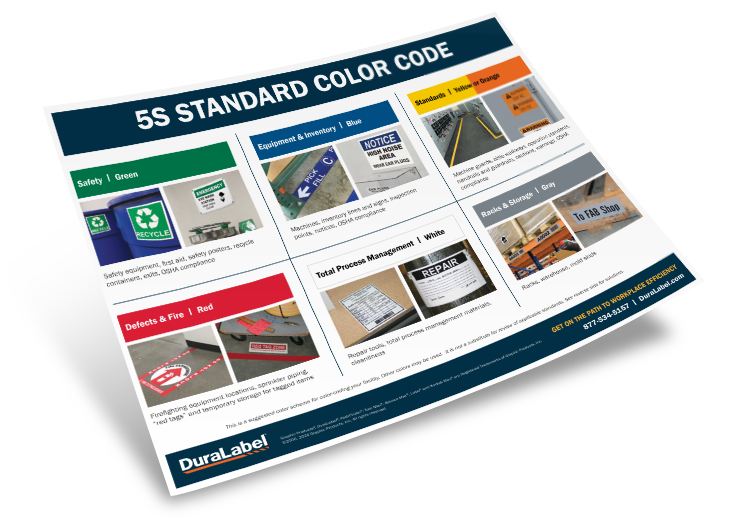Visual Workplace and Lean Manufacturing

What Is a Visual Workplace and How Does It Support Lean?
The visual workplace in Lean manufacturing uses signage, color, and labels to communicate information instantly and eliminate confusion. These Lean visual management tools form the backbone of a visual factory in manufacturing, where workflow is optimized and productivity improves through shared visual understanding.
Why the Visual Workplace Is Essential for Lean Manufacturing
When it comes to workplace improvement, it is almost second nature to think of lean manufacturing tools like Kanban, Total Productive Maintenance, and 5S methods. These tools each provide a solid framework for targeted workplace improvement that results in significant improvements in efficiency and quality. Yet many companies find that improvements do not endure after the first couple of years. How then can you ensure that your company continues to benefit from its implementation of lean manufacturing?
The answer is deceptively simple. The Visual Workplace provides the mean to support and sustain the benefits gained by implementing lean manufacturing. Developed by Gwendolyn Galsworth, the Visual Workplace's purpose is
"to share vital information about the task at hand at-a-glance, without speaking a word."
The Visual Workplace accomplishes this by first identifying where information is needed (information gaps) and then using visuals to communicate essential information.
(Source: Galsworth, Gwendolyn. Visual Workplace-Visual Thinking, Productivity Press, NYC, 2017)
Visual Tools for Identifying and Labeling Equipment
Before you can begin, it's important to get to know some of the tools of the visual workplace. While there are an unlimited number of ways you can use visuals to fill information gaps, there are some fundamental visual tools that can help get you off to the right start. Powerful visual tools include labels to identify what items are, as well as where they belong (the item's home).
Identifying What Items Are
In a manufacturing facility, for example, supplies must be precisely picked for a job. One job might require several different kinds of sheaves for a wire rope assembly. These sheaves may look identical-the difference being the actual material, bushings, and tolerances. Using the tools of the Visual Workplace, you can make it easy to tell the difference by calling out the most important information using labels or color coding.
Point-of-Use Visuals for Workers in Lean Systems
Another powerful element of the visual workplace is that it helps people quickly identify tools, supplies, and procedures, at the point-of-use. This can be done many different ways, some of which include:
- Using shadow board to identify tools and other supplies at a glance.
- Placing labels at key locations to identify critical procedures, ensuring tasks are done correctly.
- Creating mobile workstations that can be moved from one area to the next, eliminating wasted time by helping workers complete their tasks more quickly.
Mobile work stations should also take advantage of other visual communication tools like labels to ensure that workers can identify each station and place them where they belong. Strengthen the effectiveness of these stations by organizing with the 5S methodology. Teach your workforce to identify information gaps and develop lasting visual solutions-increasing efficiency, improving quality, and reducing costs.
Using Labels and Colors for Clear Visual Communication
The visual workplace ensures that accurate, timely information is available to your workers, where and when they need it. It eliminates the need to stop work to ask questions, and it reduces errors caused by incorrect, faulty, or missing information.
For example, when a gearbox is manufactured, it may be sent to another department to be assembled as part of a larger piece of equipment. During this process, workers need to know if it has passed quality assurance testing. This is where visual communication comes into play. Using visuals, manufacturing workers can mark finished gearboxes with a green label, and unfinished gearboxes with a yellow label. With this simple visual signal, workers know the state of equipment, with a simple glance.
Visual Workplace Implementation Tools
Well-placed labels and signs, communicate essential information and help ensure that tasks are done correctly-every time. DuraLabel® Industrial Sign and Label Systems can help you develop powerful visual communication solutions for almost any need. Take charge with the DuraLabel Toro Max Printer and print labels and signs where and when you need them. Using the optional lithium battery, this powerful printer lets you to print up to three hours without needing to plug it into an outlet.
Take Action Today
Ready to get started with the Visual Workplace? Download DuraLabel's Visual Workplace Management Guide for helpful training tools or call us today at 1-888-788-9936. One of our experts will help you integrate visual workplace in Lean into your workflow using proven Lean strategies and DuraLabel industrial labeling tools.
Related Resources

Continuous Improvement Ideas for the Workplace
Success in today's competitive market requires constant innovation and a vision focused on continuous ...
Read
Calculating Overall Equipment Effectiveness (OEE)
What Is Overall Equipment Effectiveness and How Is It Calculated? Overall Equipment Effectiveness (OEE) is a ...
Read
Value Stream Mapping in Lean Manufacturing
What is Value Stream Mapping? Value stream mapping is a lean manufacturing technique that follows the ...
Read.png)





